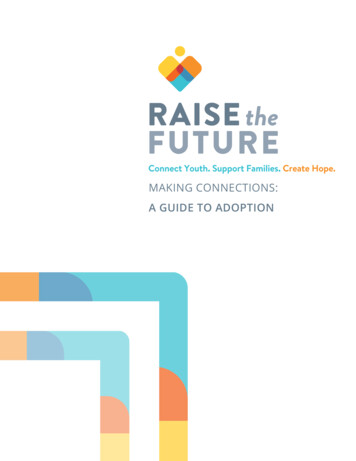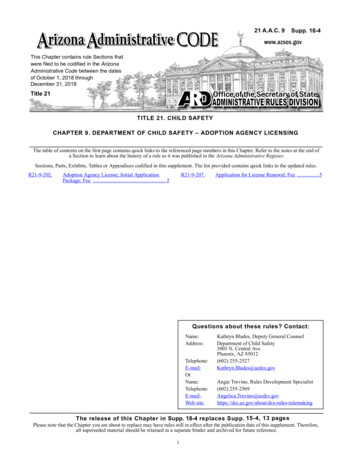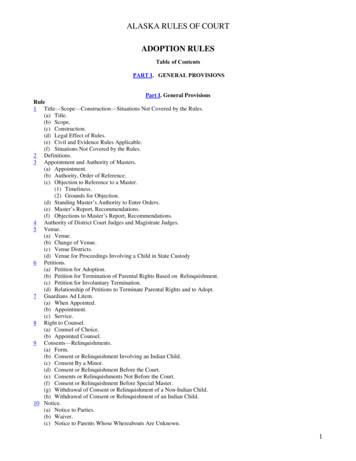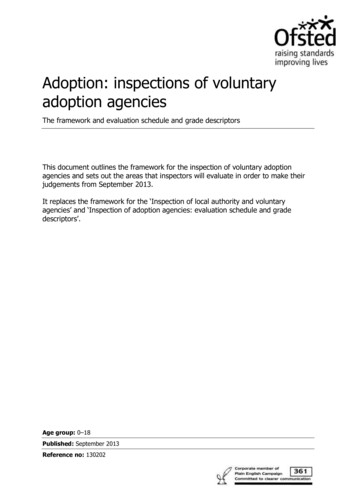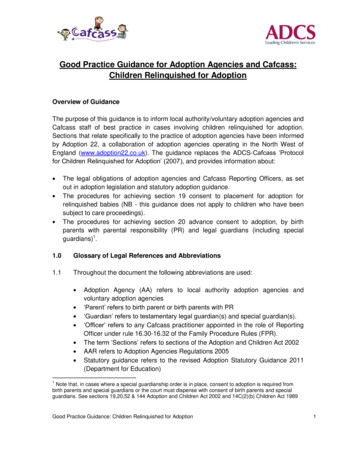
Transcription
Good Practice Guidance for Adoption Agencies and Cafcass:Children Relinquished for AdoptionOverview of GuidanceThe purpose of this guidance is to inform local authority/voluntary adoption agencies andCafcass staff of best practice in cases involving children relinquished for adoption.Sections that relate specifically to the practice of adoption agencies have been informedby Adoption 22, a collaboration of adoption agencies operating in the North West ofEngland (www.adoption22.co.uk). The guidance replaces the ADCS-Cafcass ‘Protocolfor Children Relinquished for Adoption’ (2007), and provides information about:The legal obligations of adoption agencies and Cafcass Reporting Officers, as setout in adoption legislation and statutory adoption guidance.The procedures for achieving section 19 consent to placement for adoption forrelinquished babies (NB - this guidance does not apply to children who have beensubject to care proceedings).The procedures for achieving section 20 advance consent to adoption, by birthparents with parental responsibility (PR) and legal guardians (including specialguardians)1.1.0Glossary of Legal References and Abbreviations1.1Throughout the document the following abbreviations are used:Adoption Agency (AA) refers to local authority adoption agencies andvoluntary adoption agencies‘Parent’ refers to birth parent or birth parents with PR‘Guardian’ refers to testamentary legal guardian(s) and special guardian(s).‘Officer’ refers to any Cafcass practitioner appointed in the role of ReportingOfficer under rule 16.30-16.32 of the Family Procedure Rules (FPR).The term ‘Sections’ refers to sections of the Adoption and Children Act 2002AAR refers to Adoption Agencies Regulations 2005Statutory guidance refers to the revised Adoption Statutory Guidance 2011(Department for Education)1Note that, in cases where a special guardianship order is in place, consent to adoption is required frombirth parents and special guardians or the court must dispense with consent of birth parents and specialguardians. See sections 19,20,52 & 144 Adoption and Children Act 2002 and 14C(2)(b) Children Act 1989Good Practice Guidance: Children Relinquished for Adoption1
2.0The Forms to Use2Section 19 consent to placement for adoption2.1Consent under section 19 is given in writing on the prescribed form and must beformally witnessed by a Cafcass officer whose appointment is requested by thelocal authority adoption agency. The Cafcass officer must ensure that consent isgiven unconditionally and with full understanding of what is involved (see 3.16).One of the following forms must be used:A100 - Consent to placement for adoption with any prospective adopterschosen by the Adoption AgencyA101 - Consent to the placement for adoption with identified prospectiveadopters.A102 - Consent to the placement for adoption with identified prospectiveadopter(s) and, if the placement breaks down, with any prospectiveadopter(s) chosen by the Adoption Agency.Section 20 advance consent to the making of an adoption order2.2The parent(s)/guardian(s) may also give advance consent under section 20 tothe making of an adoption order. This consent must also be witnessed formallyby a Cafcass officer appointed at the request of the AA. The form which must beused for this is:A103 – Advance consent to adoption.Statement with section 20 consent2.3At any time after giving consent under section 20 (including when interviewed bythe Cafcass officer), the parent/guardian can make a statement that they do notwish to be notified of the application for an adoption order under section 20(4).2.4If this statement is made to the Cafcass officer it should be recorded in writingand forwarded to the AA. A proforma for this is provided at annex 5 of thisguidance.3.0The Process2See Adoption – Which Form Do I Use? for additional guidance.Good Practice Guidance: Children Relinquished for Adoption2
To see a flowchart demonstrating the processes described in this guidance referto the chart in annex 1.Stage 1 – Action for AAs3.1On receiving a request from parent(s) and/or guardian(s) that their child beplaced for adoption, the adoption agency will need to notify the Cafcass officethat is closest to the parents’ address of the need for Cafcass to appoint anofficer to witness consent. In making the request, the agency will need to sendinformation to Cafcass about the case, as set out in Schedule 2 to the AAR.3.2The Cafcass office addresses can be obtained from the Cafcass website.Stage 2 – Actions for Cafcass3.3On receipt of notification from the AA, Cafcass will plan for provisional allocationto an officer for the date of the adoption panel meeting3.Stage 3 - Subsequent actions for AAs3.4During the counselling period (prior to the request to Cafcass to witness consent)the AA worker must ensure that:counselling and information has been given or offered (if refused refer toparagraph 3.5-3.11 below) to parents and guardians with PR. This caninclude fathers without PR if the agency knows their identity and decides it isappropriate (see paragraph 3.13-3.16 below).issues of competency have been considered (refer to paragraph 3.17-3.20)written information about the legal consequences of giving sections 19 and20 consent has been given to the parent(s) with PR and guardian(s) (seeannex 4).Counselling checklist for AAs3.5Understand the parent’s/guardian’s specific needs, for example:communication requirementsliteracy skills3According to the Adoption Agencies (Panel and Consequential Amendments) Regulations 2012, where achild is being relinquished and there is no court involvement in seeking a placement order, the adoptionpanel will consider the case and make a recommendation.Good Practice Guidance: Children Relinquished for Adoption3
cultural issuesdisabilitiesimmigration concernsNB - A parent under the age of 18 years can give valid consent if assessed ascompetent to do so by the AA officer.3.6Understand the reasons for requesting the child be placed for adoption. Explainother options to the parent(s)/guardian(s), including special guardianship orresidence with a relative, and advise if there are any other support services thatcould be offered to allow the child to remain with the parent(s)/guardian(s).3.7If the mother is not married, check the child’s birth certificate to establish if theunmarried birth father has acquired PR by being named on the birth certificate.(Note: the birth father without PR is not entitled to consent to placement foradoption or advance consent to adoption).3.8If the birth father is not known or not part of the relinquishing process asdescribed in paragraph 3.7, discuss with the birth mother:the birth father’s identity and addressthe birth father’s wishes and feelingswhether the birth father intends to acquire PR, outlining his role and potentialrights in the process if PR is obtained4.Responsibilities of AAs in relation to establishing the identity of the birthfather and/or birth relatives3.9Case law (Re E, (A Child) [2007] EWCA Civ 1206) has confirmed that:The law will not usually be used to force a birth mother to reveal the identityof the birth father without PR.There is no mandatory and absolute requirement in adoption law that otherrelatives should be informed of the child’s birth and the proposed adoption.3.10If the identity of the birth father without PR is known to the AA, and if the AAdecides it is appropriate so far as it is reasonably practicable, the AA mustcounsel and advise him (AAR, regulation 14), and ascertain whether he wishesto acquire PR by court order.4A birth father without PR can obtain it through a parental responsibility agreement with the mother, or aparental responsibility order made after the birth certificate has been issued.Good Practice Guidance: Children Relinquished for Adoption4
3.11Statutory Guidance5 suggests that the AA should consider whether the father hasestablished ‘family life’ with the mother and child. However, the principle that thechild’s welfare is paramount, the mother’s wishes for her child and her right toconfidentiality, and the avoidance of unnecessary delay in placing the child foradoption6, are all factors to be considered.3.12At the time that the relinquishment process begins, there are no courtproceedings. However, the AA may, in the process of their enquiries with thebirth mother, consider it necessary seek court direction on whether to notify abirth father without PR, of the plans to place his child for adoption. The FPRprovide7 ‘Where no proceedings have started an adoption agency or localauthority may ask the High Court for directions on the need to give a fatherwithout parental responsibility notice of the intention to place a child for adoption’.Applications to the High Court could add very considerable delay to the child’splacement. Such applications should not be routine, given the effect of delay onthe child.Guidance for AAs on birth fathers who subsequently acquire PR, and onthe extended family3.13A father who acquires PR after section 19 consent has been given by the motherto his child’s placement for adoption, is deemed in law to have given his consentto placement. He may withdraw this consent, and if he and/or the motherrequest(s) the child’s return, but the AA wishes to continue the adoptiveplacement, the AA must apply for a placement order (provided the child meetsthe criteria set out in section 22(1) Adoption and Children Act 2002). Whilst theapplication is before the court the local authority is not obliged to return the childto the parent(s).3.14The legal position of the extended birth family is similar to that of the birth fatherwithout PR - it is a matter of judgment by the AA as to whether contacting them isappropriate. In forming this judgment it is essential to discuss with the consentingparent(s) the likely views of the extended family, i.e. siblings, grandparents etc.,including the consequences of them discovering that the child had been born,and the consequences for the child in the extended family not knowing about thechild’s birth or the plans for adoption.5Chapter 2, paragraph 35, Statutory GuidanceWhere a birth parent has requested that a child aged under six months be placed for adoption, a proposedplacement with a suitable prospective adopter should be identified and approved by the panel within threemonths of the agency deciding that the child should be placed for adoption; chapter 4, paragraph 2,Statutory Guidance.7Rule 14.21 FPR 20106Good Practice Guidance: Children Relinquished for Adoption5
3.15The Cafcass officer will be assisted in understanding the circumstances of theconsenting parent(s) if full information is available in the Schedule 2 AAR report.However, it is not part of the Cafcass officer’s duties in witnessing sections 19and 20 consent/advance consent to challenge the AA’s decisions in respect ofbirth fathers without PR, or the extended family. Nor is it part of the officer’sduties to challenge a parent’s decision to relinquish his/her child for adoption ifthey are competent and willing to do so (provided consent is givenunconditionally and with full understanding of what is involved8).Guidance for AAs on explaining the meaning of adoption and effect of anadoption order3.16When discussing the meaning of adoption it is important to make sure that eachof the consenting parents have been made aware of:the life long implications9;the legal consequences of consenting to placement for adoption (section 19)and the advance consent to the making of an adoption order (section 20) andthe legal effects of adoption;the option of indicating that they do not want to be involved further inproceedings once they have provided section 19 and section 20 consents(see annex 5).contact issues and the legal position in respect of contact after placementand adoption;the need for information for the ‘later life’ letter and life story book for thechild;whether the relinquishing parent(s)/guardian(s) wish to be involved in thematching considerations for the prospective adoptive parents for the childand/or give their consent to placement with particular adopters;the availability of intermediary services for help in making contact with thechild when he/she is an adult (18 years and beyond) if the adopted adultconsents;the rights of the child to obtain information about his or her parent(s) oncethey reach the age of 18;the availability of support to the parents and family beyond the child’sadoption, in respect of contact, information and counselling.the role of Cafcass in ensuring that consent is given unconditionally and withfull understanding i.e. without any conditions attached, including contact;89Section 52 Adoption and Children Act 2002Section 67 Adoption and Children Act 2002Good Practice Guidance: Children Relinquished for Adoption6
the availability of written information about the adoption process (see annex4).Guidance for AAs for identifying competency3.17If, during the counselling sessions (but prior to referral to Cafcass), the AAconsiders that the parent is not capable of understanding the giving of consentand decides that the child should be placed for adoption without consent, thelocal authority must apply for a placement order (NB - a placement order cannotbe granted unless the conditions set out in section 22(1) of the Adoption andChildren Act 2002, are met).3.18Care will need to be taken if there are factors which appear to impede theparents’ level of understanding of giving consent to adoption, for example:moderate learning disabilitiesmental health issuescultural, ethnic or faith issuesconsent not being given unconditionally, e.g. parents only willing to consentwith conditions attached (NB - if consent is given in respect of a particularplacement, this not conditional consent).3.19Further information about the parent’s understanding may need to be soughtfrom another professional person, preferably someone who knows the parentsuch as an:adult learning disabilities social workerapproved mental health workermid-wife or health visitorgeneral practitionermember of cultural/faith communitypsychiatrist/psychologist3.20If the AA is aware at an early stage that issues of competency may requirefurther considerations, they should not request a Cafcass officer to witnessconsent until full enquiries have been completed. The AA must be sure that theparent or guardian is competent to give consent.Stage 4 - Completion of Schedule 2 information and documents by the AAGood Practice Guidance: Children Relinquished for Adoption7
3.21Usually Cafcass will not be contacted to request the appointment of an officer towitness consent until the AA has decided, after panel recommendation andagency decision, that the child should be placed for adoption as any other plandoes not require section 19 or section 20 consent10.3.22The law permits consent to be given before the adoption panel has met and theAA has decided that the child should be placed for adoption if the child is at leastsix weeks of age. This would be in circumstances, for example, where a motheris anxious to sign section 19 consent as soon as her child reaches six weeks ofage, and/or there is a risk that she will no longer be available to sign thereafter.3.23Section 52(3) of the Adoption and Children Act 2002 states that section 20consent is ineffective if it is given less than six weeks after the child’s birth, andaccording to the AAR, section 19 consent cannot be given until the child is sixweeks of age. Sandwell MBC v GC & Ors [2008] EWHC 2555 (Fam)3.24If the AA is satisfied that as much effort as possible has been made to counseland advise the parent wishing to sign section 19 consent, an urgent request for aCafcass officer to witness consent should be made and acted upon by Cafcassbefore the panel meeting and agency decision. This urgency is necessarybecause the AA must apply for a placement order if the mother does not sign theconsent form, and a very considerable delay to the child’s placement for adoptionmay ensue.3.25A schedule of information (Schedule 2, AAR) must be provided to Cafcass (seeproforma at annex 3). NB - this is not the similarly named Schedule 2 in the 1984Adoption Court rules. The Schedule 2 information should include the following:Legally required:a certified copy of the child's birth certificate;name and address or contact address of the parent(s)/guardian(s) whoseconsent is to be witnessed (Note: if parent is outside UK Cafcass is notrequired to witness consent)11;a chronology of actions and decisions by the agency in respect of the child;Additional information:whether the child is accommodated and in foster care;whether the AA has, with parental consent, placed the child with prospectiveadopters before the child has reached six weeks of age (AAR, regulation 35);1011See chapter 2, paragraphs 47-48 and 88 onwards of statutory guidance for additional information.FPR 2010 r.14.10(4-6)Good Practice Guidance: Children Relinquished for Adoption8
the date on which the AA decided that the child should be placed foradoption, or the projected date for the adoption panel meeting and AAdecision;confirmation by the AA that it has counselled and explained the legalimplications of both consent to placement under sections 19 and 20 andprovided the parent/guardian with written information about this together witha copy of the written information provided to him/her/them;such other information about the parent/guardian or other information as theAA considers the Cafcass officer may need to know, e.g. whether anotherprofessional’s views were sought about competency, and confirmation thatthey considered the parent/guardian to be competent;information about the lack of awareness of relatives about the child’s birth oradoption plans; for example, if the birth of the child or the plan for adoption isnot known to the birth father or relatives, what steps should be taken by theCafcass officer in arranging to meet the consenting parent/guardian topreserve their confidentiality.Stage 5 - AA Notification to Cafcass3.26The AA sends letter 2 in this guidance, enclosing the Schedule 2 AARinformation and documents requesting Cafcass to appoint a Reporting Officer.Stage 6 - Actions for Cafcass3.27There are 3 possible outcomes from interviewing the parent/guardian:i. Countersigning Section 19 Form onlyOn satisfaction that consent to placing the child for adoption has been properlygiven by the parent(s)/guardian(s) unconditionally and with full understanding ofwhat is involved, letter 3 is completed (amended appropriately) and returned tothe AA officer by Secure DX, along with the original signed form12.ii. Countersigning Section 19 and Section 20 FormsOn satisfaction that consent to placing the child for adoption and advanceconsent to the making of an adoption order is given unconditionally and with fullunderstanding of what is involved, letter 3 is completed (amended appropriately)and returned to the AA officer by Secure DX, along with the original signedforms. The letter will need to be annotated according to whether the12See ‘Adoption – Which Form Do I Use?’ for more information.Good Practice Guidance: Children Relinquished for Adoption9
parent(s)/guardian(s) have given notice to the Cafcass officer that they do notwish to be notified when an application for an adoption order is made (see annex5).iii. Inability to Countersign the Form(s)If there are issues about the parent(s)/guardian(s)’ competency to give consentunconditionally and with full understanding of what is involved which prevent theCafcass officer from countersigning the form(s), letter 4 should be completed,giving a full explanation of the reasons as to why the form(s) cannot becountersigned. This should be sent to the AA officer by Secure DX.Stage 7 - Later consent under Section 203.28Best practice would be for the parent(s)/guardian(s) to sign section 19 and 20Consent at the same time.3.29Where that is not possible, the AA should send letter 5 to the original Cafcassofficer with any additional information required. The Cafcass officer will reinterview the parent(s)/guardian(s) and, if satisfied that consent is givenunconditionally and with full understanding of what is involved, will send thecountersigned form A103 and letter 3 to the AA officer. The letter will need to beannotated according to whether the parent(s)/guardian(s) have given notice tothe Cafcass officer that they do not wish to be notified when an application for anadoption order is made (see annex 5).3.30If the Cafcass officer is unable to countersign the consent form, they shouldproceed as per point iii, 3.27.Good Practice Guidance: Children Relinquished for Adoption10
Annex 1Request by parent(s) with PR or guardian(s) toAA to place child for adoption(Letter 1)AA decides that child should be placed for adoption,taking into account the recommendations made by thepanel. In exceptional circumstances, request toCafcass can be made before the agency decision(see Stage 4)AA completes Schedule 2 information and sends with notice toCafcass by a secure delivery method, for appointment ofReporting Officer(Letter 2)Cafcass officerinterviewsparent(s)/guardian(s)with PR, or guardianwho is willing toconsentCafcass unable tocountersign forms andsends letter 4 to AAgiving explanationParent(s)/guardian(s)confirm(s) consent tosection 19 andcountersign(s) formCafcass sends Letter 3to AA with originalsigned formParent(s)/guardian(s)confirm(s) consent tosection 19 and section20 and countersign(s)formsAA notify Cafcass ifparent(s)/guardian(s) iswilling to give advanceconsent to their child’sadoption (section 20with addendum) letter 5Cafcass sends Letter3 to AA with originalsigned formsAA decides the childshould be placed foradoption withoutconsent and applicationfor placement ordermadeCafcass practitioner reinterviews parent(s)/guardian(s)Cafcass practitionerunable to countersigninterviewsparent(s)/guardian(s)Good Practice Guidance: Children Relinquished for AdoptionParent(s)/guardian(s)confirm(s) consentunder section 20 andcountersign(s);Officer sends Letter 3 toAA with original signed 11form
Annex 2Letter 1AA logo & addressCase reference noService ManagerCafcassOffice nearest to parent/guardianDearRe: Advance Notification of child to be relinquished for adoptionSections 19 and 20 Adoption and Children Act 2002I am writing to inform you that the following parent(s) has requested their child be placedfor adoption:Name of mother:Name of father [If he has PR]:Name of guardian(s) if any:Addresses for correspondence:Mother:Father:Guardian(s):Home addresses:Mother:Father:Guardian(s):Date of birth [including expected date]:Name of child [if known]:This agency believes that the parent(s)/guardian(s) are competent to give consentunconditionally and with full understanding.The mother is expected to be competent 6 weeks after the birth. The child will be 6weeks of age on the [insert date]and the mother will be competent togive consent on this date [insert date].The projected date for the adoption panel recommendation, agency decision andcompletion of the Schedule 2 Information for Cafcass is [insert date]Good Practice Guidance: Children Relinquished for Adoption.12
Yours sincerelyName of officerGood Practice Guidance: Children Relinquished for Adoption13
Annex 2Letter 2AA logo & addressCase reference noService ManagerCafcassOffice nearest to parent/guardianDearRe: Notification of child to be relinquished for adoptionI enclose the completed Schedule 2 Information with associated documents and requestthe appointment of an officer to witness Section 19 consent and advance consent to themaking of an adoption order Section 20 consent: [delete as appropriate]a) with specific adoptersb) with any adopters chosen by the agencyAnd confirm the parent/guardian wish: [delete as appropriate]a) to give advance consent to the making of an adoption orderb) do not wish to be notified of the adoption order application in respect of theirchild.Name of mother: [if willing to consent]:Name of father [if he has PR and is willing to consent]:Name of guardians [if willing to consent]:Addresses for correspondence:Mother:Father:Guardian(s):Home addressesMother:Father:Guardian(s):Name and date of birth of child:I have enclosed the Schedule 2 Information, which contains the following:certified copy of the child’s birth certificateGood Practice Guidance: Children Relinquished for Adoption14
names and addresses or preferred contact addresses of the child'sparents/guardians who are willing to give consentchronology of actions and decisions taken by the agency, including the date orprojected date when the agency decided or will decide, that the child should beplaced for adoption.I confirm that:the agency has counselled and explained to the parent(s)/guardian(s) the legalimplications of both consent to placement under section 19 of the Act and consent tothe making of an adoption order under section 20 of the Act.a copy of the above written information has provided to the parent(s)/guardian(s)All such other additional information as the AA considers the officer of the serviceneeds to know has been provided to Cafcass.At the time of writing there are no known unresolved concerns about the parent’s orguardian’s competency to give consent unconditionally and with full understanding ofwhat is involved.Yours sincerelyName of officerGood Practice Guidance: Children Relinquished for Adoption15
Annex 2Letter 3Cafcass & addressName of officer [AA]AddressCase reference noDearRelinquished childRe: Countersigning Consent FormsWith reference to your request for the appointment of an officer to witness consent toplacement for adoption and advance consent to the making of an adoption order [deleteif not appropriate], I am writing to inform you that I have witnessed and countersignedthe following:Section 19 consent Form [delete if not appropriate]Section 20 consent Form [delete if not appropriate]The parent/guardian gave me notice that they do not wish to be notified of the adoptionorder application in respect of their child [delete if not appropriate]The original signed consent forms and notice are enclosed and relate to:Name of mother:Name of father:Name of guardian[s]:Name of child:Yours sincerelyName of officerN.B.Please return the original consent forms to AA by a secure delivery methodGood Practice Guidance: Children Relinquished for Adoption16
Annex 2Letter 4Cafcass & addressName of officer [AA]AddressCase reference noDearRelinquished childRe: Inability to Countersign Consent Forms - Section 19 and 20With reference to your request for the appointment of an officer to witness consent toplacement for adoption and advance consent to the making of an adoption order [deleteif not appropriate], I write to inform you that I have not been able to countersign thefollowing:Section 19 consent Form [delete if not appropriate]Section 20 consent Form [delete if not appropriate]In relation to:Name of mother:Name of father:Name of guardian[s]:Name of child:The reasons that I do not consider that the parent(s)/guardian(s) are able/willing to giveconsent unconditionally and with full understanding of what is involved are:Yours sincerelyName of officerGood Practice Guidance: Children Relinquished for Adoption17
Annex 2Letter 5AA logo & addressCase reference noService ManagerCafcassOffice nearest to parent/guardianDearRelinquished childRe: Countersigning of Advance Consent for AdoptionWith reference to your correspondence of [insert date] witnessing the signing of aSection 19 consent form in relation to:Name of mother: [if appropriate]:Name of father [if appropriate]:Name of guardian(s) [if appropriate]:Addresses for correspondence:Mother:Father:Guardian(s):I am writing to request that you witness the signing of a Section 20 advance consent tothe making of an adoption order and, if it is given to you by the parent(s)/guardian(s),receive from them notice that they do not wish to be informed about the adoption orderapplication in respect of their child.I have enclosed an addendum to the Schedule 2 Information previously sent to you on[insert date].Yours sincerelyName of officerGood Practice Guidance: Children Relinquished for Adoption18
Annex 3Schedule 2 proformaSection 19 or Section 20 Consent - Adoption Agencies Regulations 2005Name of Agency:Address:Telephone Number:Fax Number:Date form completed:Name of Social Worker completing this formTelephone Number:E-mail address:Name of Team Manager:Telephone Number E- mail:Signature and date: .Date (or projected date) of adoption panel recommendation that the child should beplaced for adoption:Date (or projected date) of agency decision that the child should be placed for adoption:N.B.A certified copy of the child's birth certificate MUST be attachedThe childSurname:First Names:Other names child is known by:Gender:Date of Birth:Information about the parent(s)/guardian(s) whose consent is to be witnessed:MotherSurname:First Names:Date of birth:Marital Status:Address for contact by Cafcass:Tel no:Good Practice Guidance: Children Relinquished for Adoption19
Father (to be completed only if father has Parental Responsibility)Surname:First names:Date of birth:Address for contact by Cafcass:Tel No:Guardian(s)Surname:First names:Address for contact by Cafcass:Tel No:Additional information:Is the child accommodated (section 20 Children Act 1989)? Yes/NoIs the child in foster care? Yes/NoIs the child placed with identified carers who may wish to adopt? Yes/NoConfirmation by AA that it has counselled or attempted to counsel the consentingparent(s)/guardian(s) and explained the legal implications of consent toplacement under section 19 and section 20, and provided theparent(s)/guardian(s) with the information in writing. A copy of the informationmust be attached to this document.Chronology of actions and decisions taken by agency. This should in
by Adoption 22, a collaboration of adoption agencies operating in the North West of England (www.adoption22.co.uk). The guidance replaces the ADCS-Cafcass 'Protocol for Children Relinquished for Adoption' (2007), and provides information about: The legal obligations of adoption agencies and Cafcass Reporting Officers, as set out in adoption .

